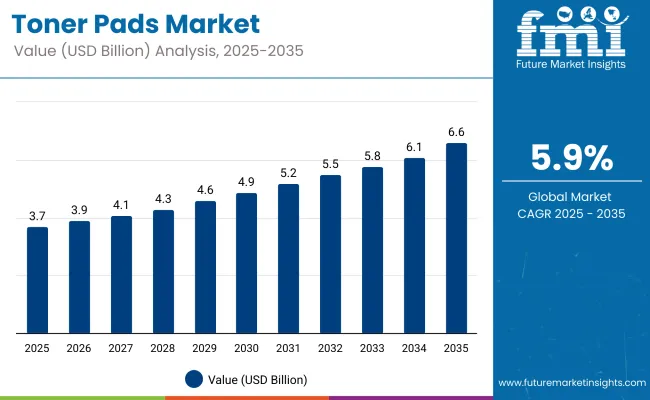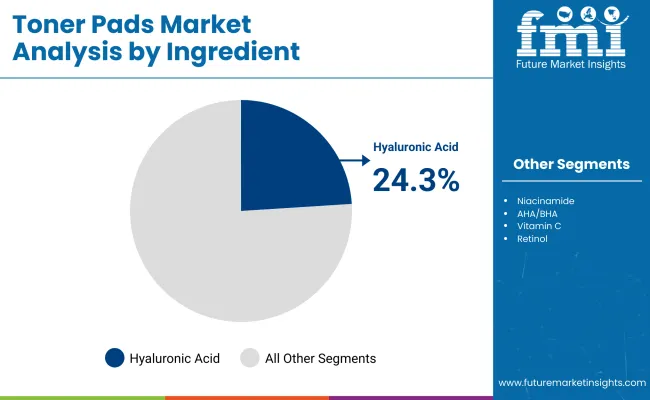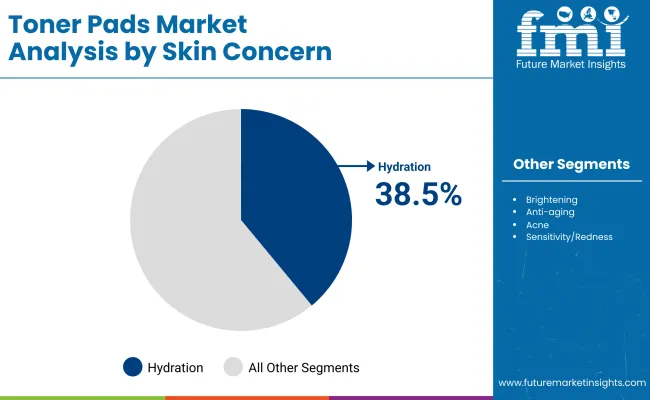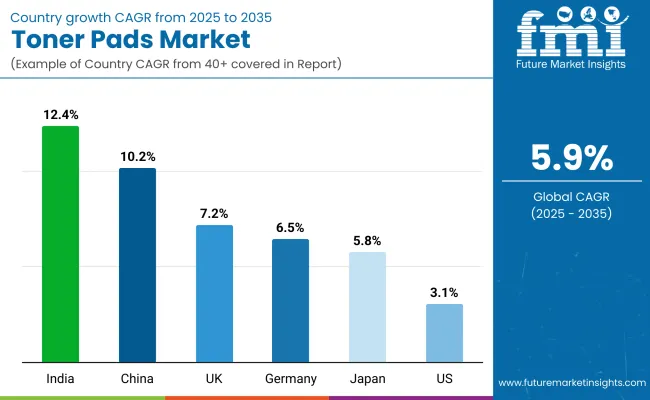The Global Toner Pads Market is expected to record a valuation of USD 3.70 billion in 2025 and USD 6.56 billion in 2035, with an increase of USD 2.86 billion, which equals a growth of 77.3% over the decade. The overall expansion represents a CAGR of 5.9% and nearly a 1.8X increase in market size.

Global Toner Pad Market Key Takeaways
| Metric | Value |
| Market Estimated Value in (2025E) | USD 3.70 billion |
| Market Forecast Value in (2035F) | USD 6.56 billion |
| Forecast CAGR (2025 to 2035) | 5.9% |
During the first five-year period from 2025 to 2030, the market is forecast to grow from USD 3.70 billion to USD 4.92 billion, adding USD 1.22 billion, which accounts for 42.6% of the total decade growth. This phase records steady adoption in skincare routines across professional spas and at-home beauty care, driven by rising awareness of dermatological health. Other skin concern toner pads dominate this period as they cater to over 61.5% of demand, addressing diverse skin conditions beyond hydration and anti-aging.
The second half from 2030 to 2035 contributes USD 1.64 billion, equal to 57.4% of total growth, as the market expands from USD 4.92 billion to USD 6.56 billion. This acceleration is powered by premiumization trends, clean beauty formulations, and expansion into emerging markets such as India and China.
Brands are leveraging subscription models, eco-friendly packaging, and dermatologically tested ingredient combinations to capture loyalty. Offline retail and beauty chain partnerships remain critical for experiential sales and consumer education.
From 2020 to 2024, the Global Toner Pads Market grew from USD 2.93 billion to USD 3.54 billion, driven by rising skincare awareness and premium self-care product adoption. During this period, the competitive landscape was dominated by beauty and personal care brands controlling nearly 70% of revenue, with leaders such as L’Oréal, Shiseido, and Estée Lauder focusing on diversified ingredient formulations for global markets.
Competitive differentiation relied on dermatological efficacy, hypoallergenic profiles, and eco-friendly packaging innovations, while digital marketing and influencer collaborations accelerated brand visibility. Professional spa-based toner pad usage remained niche, contributing less than 10% of the total market value.
Demand for toner pads is expected to expand to USD 3.70 billion in 2025, with the revenue mix shifting towards specialized ingredient blends and function-specific skin concerns. Traditional leaders face rising competition from K-beauty and clean beauty brands offering innovative multi-layered pads, biodegradable materials, and active ingredient targeting for sensitive skin.
Offline beauty retail chains and dermatologist-led recommendations continue to strengthen product trust, while e-commerce platforms diversify distribution. The competitive edge is moving towards sustainable sourcing, patented formulations, and region-specific product customization.
Advancements in skincare formulations have improved the efficacy and convenience of toner pads, enabling faster absorption, targeted delivery of active ingredients, and reduced skin irritation. The increasing popularity of multifunctional products has positioned toner pads as a go-to solution for cleansing, exfoliating, and hydrating in a single step, appealing to busy consumers seeking simplified routines. Growth in K-beauty trends, combined with rising awareness of preventive skincare, has boosted adoption across both younger and mature demographics.
Social media marketing, influencer collaborations, and dermatologist endorsements have significantly increased brand visibility and consumer trust. Rising disposable incomes in emerging markets, alongside the expansion of premium and organic product lines, are driving value growth. Offline channels such as beauty retail chains continue to dominate in many regions due to in-store consultations and sampling, while e-commerce platforms are rapidly capturing younger, tech-savvy customers. Segment expansion is being fueled by demand for other ingredient types with high functional benefits and products addressing specific skin concerns like sensitivity, dullness, and uneven texture.
The Global Toner Pads Market is segmented by ingredient type, skin concern, skin type, packaging type, and distribution channel. Ingredient types include AHA, BHA, PHA, retinol, vitamin C, niacinamide, hyaluronic acid, heartleaf/houttuynia, tea tree, and centella, catering to varied skincare needs. Skin concerns addressed by toner pads span acne and blemish care, brightening and dark spot reduction, pore and blackhead care, sensitivity and soothing, hydration, and anti-aging or firming.
Segmentation by skin type covers oily, combination, dry, normal, and sensitive categories, ensuring targeted product suitability. Packaging types include jars or canisters with tweezers, refill packs, single-use sachets, and travel minis, offering convenience and portability. Distribution channels are divided into online (direct-to-consumer brand websites and e-commerce marketplaces) and offline (beauty retail chains, department stores, specialty beauty boutiques, and dermatology clinics or medical spas). Regionally, demand is strong across North America, Asia-Pacific, and Europe, with China, India, and the USA driving growth through ingredient innovation, customized formulations, and expansion of omnichannel retail strategies.

| Ingredient Type | Value Share% 2025 |
|---|---|
| Hyaluronic acid | 24.3% |
| Others | 75.7% |
The Hyaluronic acid segment is projected to contribute 24.3% of the Global Toner Pads Market revenue in 2025, maintaining its position as the most dominant formulation category. This leadership stems from the inclusion of high-performance actives such as peptides, antioxidants, fermented extracts, and botanical complexes that offer multifunctional benefits in a single product. Brands have increasingly focused on combining these ingredients to target multiple skin concerns, including hydration, brightening, and barrier repair, in a convenient pad format.
| Ingredient Type | Value Sales USD Million |
|---|---|
| Hyaluronic acid | 898.89 |
| Others | 2800.23 |
Consumer interest in unique and innovative formulations, particularly those influenced by Korean and Japanese skincare trends, has supported rapid adoption across both premium and mass-market brands. The versatility of this category has enabled manufacturers to cater to diverse skin types and seasonal skincare needs, reinforcing its role as a key revenue driver in the market.

| Skin Concern | Value Share% 2025 |
|---|---|
| Hydration | 38.5% |
| Others | 61.5% |
The Hydration skin concern segment is forecasted to hold 38.5% of the market share in 2025, led by its focus on addressing a wide range of conditions such as sensitivity, dullness, uneven skin tone, and barrier damage. These products have been designed to provide gentle yet effective care, often incorporating soothing agents like centellaasiatica, chamomile, or oat extract. Their adaptability to different climates and lifestyles has contributed to steady demand in both developed and emerging markets.
| Skin Concern | Value Sales USD Million |
|---|---|
| Hydration | 1424.16 |
| Others | 2274.96 |
This segment’s growth is further fueled by consumer education on skin barrier health and preventive care, supported by dermatologist recommendations and influencer-driven awareness campaigns. As beauty consumers increasingly seek personalized solutions beyond standard anti-aging or acne care, this segment is expected to retain a strong presence throughout the forecast period.
| Distribution Channel | Value Share% 2025 |
|---|---|
| Offline | 58.7% |
| Others | 41.3% |
The offline distribution channel segment is projected to account for 58.7% of the Global Toner Pads Market revenue in 2025, solidifying its position as the primary sales avenue. This dominance is attributed to the consumer preference for in-person product trials, texture assessment, and expert consultations before purchase. Beauty retail chains, department stores, and specialty skincare outlets have leveraged curated displays, exclusive launches, and in-store events to attract shoppers and enhance brand engagement.
| Distribution Channel | Value Sales USD Million |
|---|---|
| Offline | 2171.38 |
| Others | 1527.74 |
The offline channel also benefits from impulse purchases driven by visual merchandising and promotional bundling. While online sales are rapidly expanding, particularly among younger consumers, offline retail remains the go-to platform for premium and mid-tier toner pad brands seeking to build trust and showcase product performance firsthand. Strategic partnerships with global beauty retailers and regional distributors are expected to sustain this channel’s lead over the forecast horizon.
Ingredient Innovation and Multi-Benefit Skincare Adoption
The Global Toner Pads Market is witnessing strong adoption across skincare categories as consumers seek convenient, targeted, and effective solutions. These pre-soaked pads deliver consistent doses of actives such as niacinamide, hyaluronic acid, salicylic acid, and botanical extracts, eliminating the need for separate application tools. Their compact packaging, spill-proof design, and ease of use have made them a preferred choice for on-the-go skincare and travel-friendly routines.
Manufacturers are responding with ingredient innovations that combine hydration, exfoliation, and brightening benefits in a single pad, appealing to time-conscious urban consumers. The popularity of Korean and Japanese beauty formats has accelerated global demand, with social media campaigns and influencer endorsements expanding reach. Premium brands are emphasizing dermatologist-tested formulations and clean-label positioning to attract health-conscious buyers. The growing male grooming segment and the increasing influence of beauty subscription services are further shaping purchasing behaviors.
Price Sensitivity and Environmental Concerns
While adoption is expanding, price sensitivity continues to challenge premium toner pad penetration in emerging economies. Formulations with advanced actives and biodegradable pad substrates often come at higher production costs, resulting in retail prices above traditional liquid toners. This limits accessibility among price-conscious consumers, particularly in Asia-Pacific and Latin America. Shelf-life management remains a concern, as pads risk drying out if packaging seals are compromised during transit or storage.
Environmental impact is another factor, with single-use pads contributing to waste concerns, prompting brands to explore compostable materials and refill systems. Consumer hesitation also persists among those loyal to traditional toner formats, perceiving pads as less economical. Educating users about benefits such as controlled dosing, reduced spillage, and skin-contact hygiene will be essential to drive wider adoption and address sustainability expectations.

| Countries | Estimated CAGR (2025 to 2035) |
|---|---|
| China | 10.2% |
| USA | 3.1% |
| India | 12.4% |
| UK | 7.2% |
| Germany | 6.5% |
| Japan | 5.8% |
The global Toner Pads Market shows a pronounced regional disparity in adoption speed, strongly influenced by skincare product innovation, premium beauty retail penetration, and consumer awareness campaigns.
Asia-Pacific emerges as the fastest-growing region, anchored by China at 10.2% CAGR and India at 12.4%. This acceleration is driven by the popularity of Korean and Japanese beauty formats, rapid expansion of domestic cosmetic manufacturing, and government initiatives supporting local beauty and personal care production. China’s thriving e-commerce platforms and influencer-driven marketing further accelerate adoption of premium toner pads across both urban and semi-urban markets. India’s growth reflects rising disposable incomes, urbanization, and adoption of multifunctional skincare solutions catering to diverse skin concerns.
Europe maintains a strong growth profile, led by Germany at 6.5% and the UK at 7.2%, supported by stringent cosmetic safety regulations, sustainability-driven packaging innovations, and the dominance of pharmacy and specialty beauty chains. The region’s focus on clean beauty and eco-friendly formulations positions it ahead of North America in per capita premium skincare spending. North America shows moderate expansion, with the USA at 3.1% CAGR, reflecting maturity in core skincare segments and a shift toward clean-label, dermatologist-backed brands. Growth in North America is increasingly driven by online DTC channels, subscription beauty boxes, and collaborations with celebrity skincare lines rather than traditional mass retail formats.
| Year | USA Toner Pad Market (USD Billion) |
|---|---|
| 2025 | 965.47 |
| 2026 | 1006.48 |
| 2027 | 1049.23 |
| 2028 | 1093.79 |
| 2029 | 1140.25 |
| 2030 | 1188.68 |
| 2031 | 1239.17 |
| 2032 | 1291.80 |
| 2033 | 1346.67 |
| 2034 | 1403.87 |
| 2035 | 1463.50 |
The Toner Pad Market in the United States is projected to grow at a CAGR of 4.3%, supported by rising consumer focus on targeted skincare routines and premium beauty formulations. The offline retail segment continues to lead sales, with beauty chains and department stores offering experiential product testing and bundling with complementary skincare lines. Dermatologist-recommended toner pads with active ingredients are gaining popularity among consumers seeking quick and convenient application. E-commerce penetration is growing steadily, with subscription-based models emerging as a retention strategy for brands.
The Toner Pad Market in the United Kingdom is expected to grow at a CAGR of 7.2%, supported by rising adoption of multifunctional skincare products, clean beauty formulations, and premium cosmetic routines. Luxury skincare retailers are increasingly offering toner pads as part of bundled treatment kits, while spas and salons incorporate them into facial services. Sustainability-conscious consumers are driving demand for biodegradable pad materials and refillable packaging. Government-backed campaigns promoting cruelty-free and eco-friendly cosmetics are further fueling awareness.
India is witnessing rapid growth in the Toner Pad Market, which is forecast to expand at a CAGR of 12.4% through 2035. The surge is fueled by expanding beauty retail chains in tier-2 and tier-3 cities, coupled with growing awareness of ingredient-based skincare. Local brands are offering toner pads with herbal and Ayurvedic formulations to appeal to traditional preferences while targeting the younger demographic with K-beauty-inspired innovations. E-commerce platforms are accelerating access through influencer-led campaigns and subscription delivery models.
The Toner Pad Market in China is expected to grow at a CAGR of 10.2%, the highest among major economies. Growth is driven by strong demand for brightening, hydrating, and anti-aging pads within a booming skincare sector. Domestic brands are aggressively launching targeted formulations for sensitive and combination skin, while international brands leverage cross-border e-commerce to reach younger consumers. Offline retail remains a dominant sales channel, supported by beauty counters in malls and specialty cosmetic stores.
| Countries | 2025 Share (%) |
|---|---|
| USA | 20.3% |
| China | 14.7% |
| Japan | 9.6% |
| Germany | 7.7% |
| UK | 6.4% |
| India | 4.9% |
| Countries | 2035 Share (%) |
|---|---|
| USA | 17.3% |
| China | 15.3% |
| Japan | 8.6% |
| Germany | 7.0% |
| UK | 5.8% |
| India | 8.4% |
The Global Toner Pads Market in Germany is projected to grow at a CAGR of 6.5%, supported by its strong presence in premium skincare manufacturing and advanced cosmetic formulation capabilities. German beauty brands are incorporating multifunctional toner pads into their product lines, focusing on dermatologically tested ingredients and eco-friendly packaging.
Professional skincare clinics are adopting toner pads enriched with active botanicals for post-treatment soothing and hydration. Compliance with EU cosmetic safety standards and consumer demand for sustainable, high-efficacy products are further accelerating adoption in both retail and professional segments.
| USA By Ingredient Category | Value Share% 2025 |
|---|---|
| Hyaluronic acid | 25.2% |
| Others | 74.8% |
| USA By Ingredient Category | Value Sales USD Million |
|---|---|
| Hyaluronic acid | 243.30 |
| Others | 722.17 |
The Global Toner Pads Market in the USA is projected at USD 965.47 million in 2025. Hyaluronic acid contributes 25.2%, while other ingredients hold 74.8%, reflecting strong demand for multifunctional and diverse formulations beyond single-ingredient focus. This ingredient diversity caters to a wider range of skin concerns, from hydration to exfoliation and soothing.
The popularity of hyaluronic acid stems from its proven hydrating and plumping benefits, making it a staple in anti-aging and daily skincare routines. USA consumers are increasingly seeking dermatologist-tested, cruelty-free, and eco-friendly toner pads, boosting both premium and mass-market adoption. As personalization trends grow, brands are offering pads with targeted actives for specific skin types and conditions, enhancing consumer loyalty and repeat purchases.
| China By Skin Concern | Value Share% 2025 |
|---|---|
| Hydration | 41.2% |
| Others | 58.8% |
The Global Toner Pads Market in China is valued at USD 542.02 million in 2025, with hydration-focused pads leading at 41.2%, followed by other benefits at 58.8%. The dominance of hydration products reflects China’s consumer preference for moisture-rich skincare, especially in urban areas with high pollution and seasonal dryness. Hydration pads are a key tool for improving skin barrier function, making them essential in daily beauty regimens.
| China By Skin Concern | Value Sales USD Million |
|---|---|
| Hydration | 223.31 |
| Others | 318.71 |
Portability, single-use convenience, and compatibility with multi-step routines further enhance adoption, particularly among younger demographics and working professionals. While exfoliation and brightening pads hold a notable share, hydration remains the gateway segment driving trial and repeat purchases. As clean beauty and minimalist skincare trends expand, hydration-focused toner pads with natural extracts are expected to retain market leadership.

The Global Toner Pads Market is moderately fragmented, with global leaders, mid-sized innovators, and niche-focused specialists competing across diverse skincare categories. Established Korean beauty leaders such as COSRX, Mediheal, and Innisfree hold significant market share, driven by broad product portfolios, clinically backed formulations, and expansive distribution through both offline retail and online platforms. Their strategies increasingly emphasize gentle, skin-friendly actives, hydration-focused solutions, and eco-conscious packaging to strengthen brand loyalty in both domestic and international markets.
Mid-sized players, including Neogen, Goodal, and Dr.G, cater to the growing demand for targeted skincare treatments and multifunctional toner pads. These companies are accelerating adoption through innovation in active ingredient blends, dermatologist-tested claims, and hybrid sales models that combine direct-to-consumer channels with specialty beauty retailers. Their focus on niche concerns such as brightening, soothing, and anti-aging enables them to capture high-value segments within competitive price brackets.
Specialized providers and emerging trend-driven brands such as Anua, Round Lab, Abib, and Some ByMi focus on natural ingredient sourcing, minimalist formulations, and sensitive skin compatibility. Their strength lies in customization, region-specific product adaptation, and leveraging influencer-led social media marketing rather than pursuing a broad global footprint. Competitive differentiation is shifting from single-step products toward integrated routines that combine exfoliation, hydration, and treatment in one, with subscription-based replenishment models gaining popularity among urban consumers.
Key Developments in Global Toner Pads Market
| Item | Value |
|---|---|
| Quantitative Units | USD 3.70 billion (2025E) |
| Ingredient Category | Hyaluronic Acid, Niacinamide, AHA/BHA, Vitamin C, Retinol, Peptides, and Others |
| Skin Concern | Hydration, Brightening, Anti-aging, Acne, Sensitivity/Redness, and Others |
| Distribution Channel | Online DTC + E-commerce, Beauty Retail Chains (Sephora, Ulta), Department Stores, Supermarkets/Hypermarkets, Specialty Beauty Stores, and Others |
| End User | Women (All Age Groups), Professional Use (Dermatology & Spas), and Men’s Grooming |
| Regions Covered | North America, Europe, Asia-Pacific, Latin America, Middle East & Africa |
| Countries Covered | United States, Canada, Germany, France, United Kingdom, China, Japan, India, Brazil, South Africa |
| Key Companies Profiled | COSRX, Mediheal, Some By Mi, Neogen, Innisfree, Anua, Skinfood, Mixsoon, Abib, Medicube, Goodal, Round Lab, Dr. Ceuracle, Beplainm, First Aid Beauty |
| Additional Attributes | Dollar sales by ingredient category and skin concern, adoption trends in multifunctional skincare, rising demand for hydration and anti-aging products, sector-specific growth in offline beauty retail, software and device compatibility for hybrid skincare regimens, integration with smart skincare devices, regional trends influenced by premium beauty adoption, and innovations in clean formulations, sustainable packaging, and personalized skincare |
The global Toner Pads Market is estimated to be valued at USD 3,699.1 million in 2025.
The market size for the Global Toner Pads Market is projected to reach USD 6,562.8 million by 2035.
The Global Toner Pads Market is expected to grow at a 5.9% CAGR between 2025 and 2035.
The key ingredient categories in the Toner Pads Market are Hyaluronic Acid, Niacinamide, AHA/BHA, Vitamin C, Retinol, Peptides, and Others.
In terms of skin concern, the Other Skin Concern segment is expected to command 61.5% share in the Global Toner Pads Market in 2025.






Our Research Products

The "Full Research Suite" delivers actionable market intel, deep dives on markets or technologies, so clients act faster, cut risk, and unlock growth.

The Leaderboard benchmarks and ranks top vendors, classifying them as Established Leaders, Leading Challengers, or Disruptors & Challengers.

Locates where complements amplify value and substitutes erode it, forecasting net impact by horizon

We deliver granular, decision-grade intel: market sizing, 5-year forecasts, pricing, adoption, usage, revenue, and operational KPIs—plus competitor tracking, regulation, and value chains—across 60 countries broadly.

Spot the shifts before they hit your P&L. We track inflection points, adoption curves, pricing moves, and ecosystem plays to show where demand is heading, why it is changing, and what to do next across high-growth markets and disruptive tech

Real-time reads of user behavior. We track shifting priorities, perceptions of today’s and next-gen services, and provider experience, then pace how fast tech moves from trial to adoption, blending buyer, consumer, and channel inputs with social signals (#WhySwitch, #UX).

Partner with our analyst team to build a custom report designed around your business priorities. From analysing market trends to assessing competitors or crafting bespoke datasets, we tailor insights to your needs.
Supplier Intelligence
Discovery & Profiling
Capacity & Footprint
Performance & Risk
Compliance & Governance
Commercial Readiness
Who Supplies Whom
Scorecards & Shortlists
Playbooks & Docs
Category Intelligence
Definition & Scope
Demand & Use Cases
Cost Drivers
Market Structure
Supply Chain Map
Trade & Policy
Operating Norms
Deliverables
Buyer Intelligence
Account Basics
Spend & Scope
Procurement Model
Vendor Requirements
Terms & Policies
Entry Strategy
Pain Points & Triggers
Outputs
Pricing Analysis
Benchmarks
Trends
Should-Cost
Indexation
Landed Cost
Commercial Terms
Deliverables
Brand Analysis
Positioning & Value Prop
Share & Presence
Customer Evidence
Go-to-Market
Digital & Reputation
Compliance & Trust
KPIs & Gaps
Outputs
Full Research Suite comprises of:
Market outlook & trends analysis
Interviews & case studies
Strategic recommendations
Vendor profiles & capabilities analysis
5-year forecasts
8 regions and 60+ country-level data splits
Market segment data splits
12 months of continuous data updates
DELIVERED AS:
PDF EXCEL ONLINE
Destoner Machine Market Trend Analysis Based on Product Type, End-Use, Automation, and Region 2025 to 2035
AHA Toners Market Size and Share Forecast Outlook 2025 to 2035
Skin Toner Market Size and Share Forecast Outlook 2025 to 2035
Examining Market Share Trends in the Meat Pads Industry
Brake Pads and Shoes Market Size and Share Forecast Outlook 2025 to 2035
Layer Pads Market from 2025 to 2035
Corner Pads Market Insights - Growth & Demand 2025 to 2035
Tipper Pads Market
Sleeper Pads Market Size and Share Forecast Outlook 2025 to 2035
Scouring Pads Market Size and Share Forecast Outlook 2025 to 2035
Printing Toners Market Size and Share Forecast Outlook 2025 to 2035
Mattress Pads Market Analysis - Size, Share, and Forecast Outlook 2025 to 2035
Beverage Cartoners Market Size and Share Forecast Outlook 2025 to 2035
Exfoliating Pads Market Analysis - Size and Share Forecast Outlook 2025 to 2035
Witch Hazel Toners Market Size and Share Forecast Outlook 2025 to 2035
Glycolic Acid Toners Market Analysis - Size, Share, and Forecast Outlook 2025 to 2035
Wrap Around Cartoners Market Size and Share Forecast Outlook 2025 to 2035
Anti-pollution Toner Market Size and Share Forecast Outlook 2025 to 2035
Die Cut Support Pads Market Size and Share Forecast Outlook 2025 to 2035
Heated Mattress Pads Market

Thank you!
You will receive an email from our Business Development Manager. Please be sure to check your SPAM/JUNK folder too.
Chat With
MaRIA